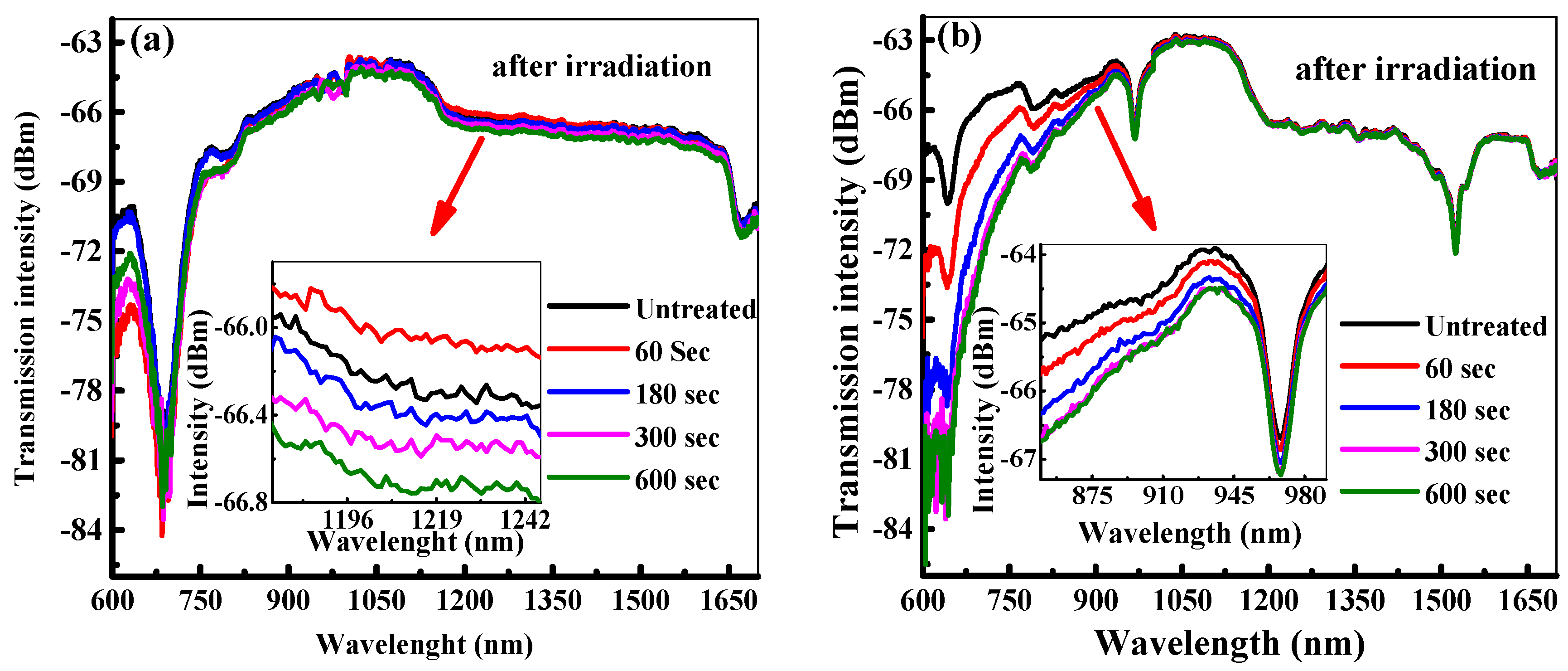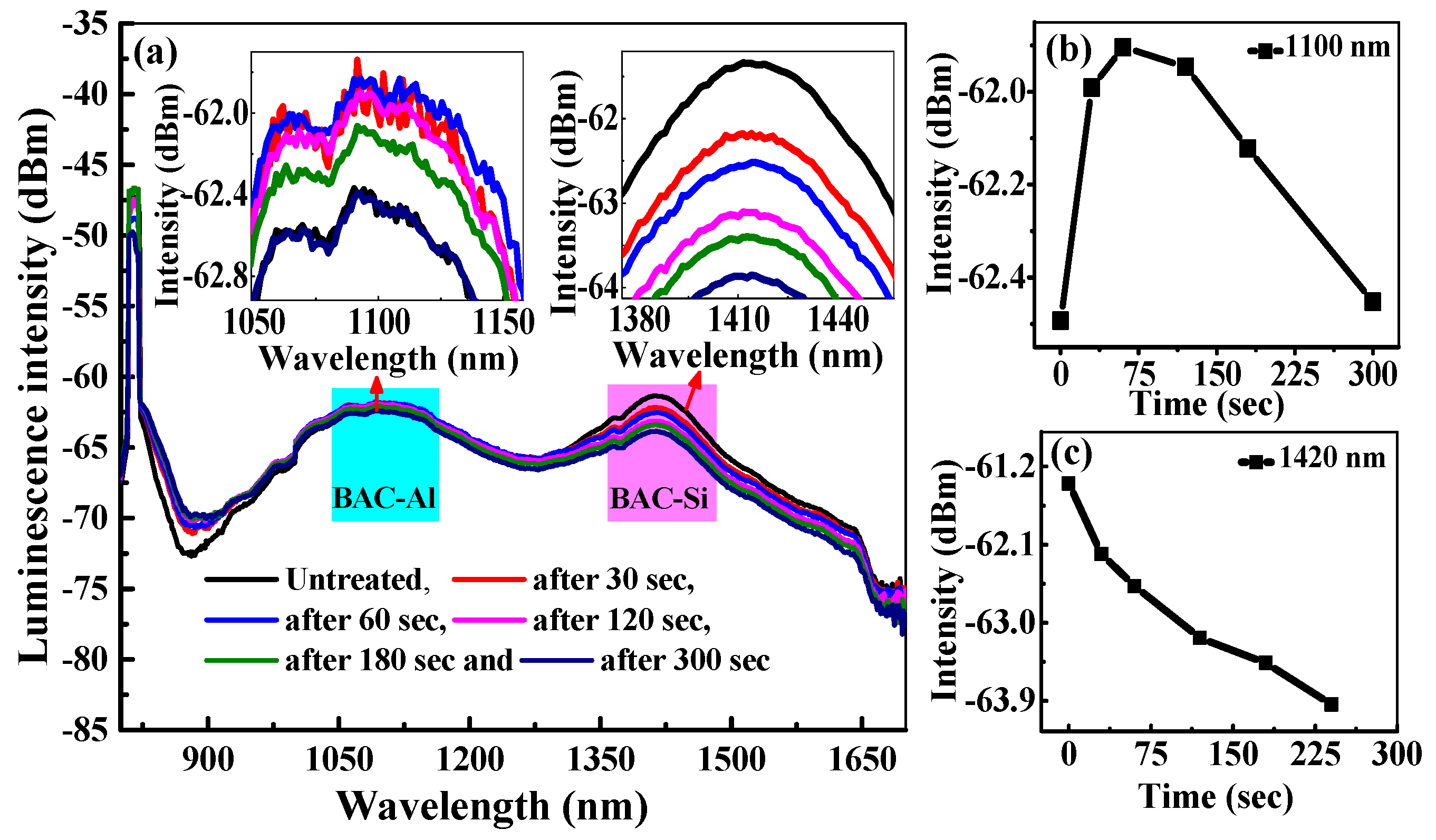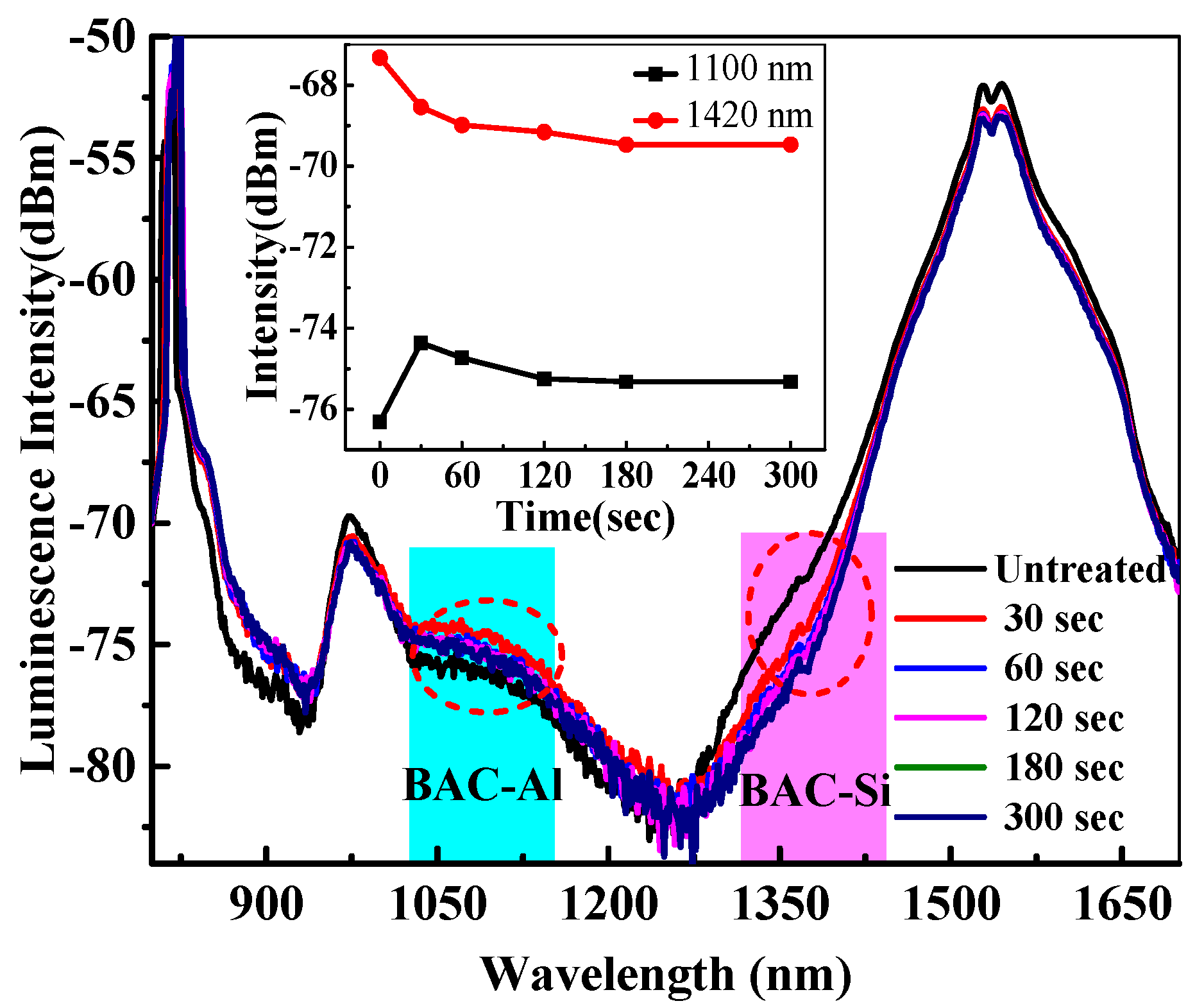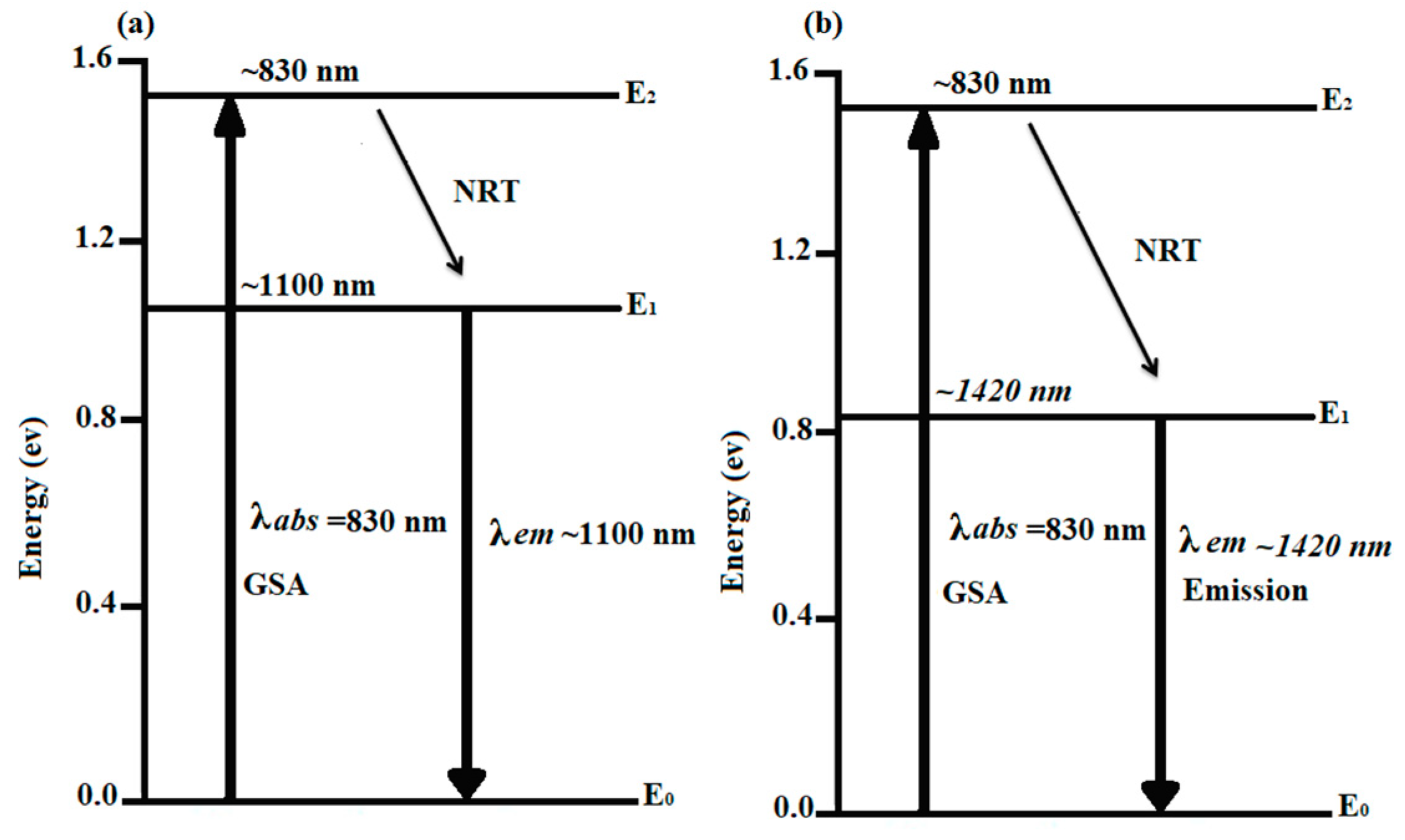Ultraviolet Irradiation Effects on luminescent Centres in Bismuth-Doped and Bismuth-Erbium Co-Doped Optical Fibers via Atomic Layer Deposition
Abstract
:1. Introduction
2. Experiment Setup
2.1. Description of the Fibers and Equipment
2.2. Experiments Methodology
3. Results and the Discussions
3.1. Transmission Spectra of BDF and BEDF Before and After UV Irradiation
3.2. Luminescence Spectra of BDF and BEDF Before and After UV Irradiation
4. Conclusions
Author Contributions
Funding
Conflicts of Interest
References
- Dianov, E.M. Amplification in extended transmission bands using bismuth-doped optical fibers. J. Lightw. Technol. 2013, 31, 681–688. [Google Scholar] [CrossRef]
- Trukhin, A.; Teteris, J.; Bazakutsa, A.; Golant, K. Impact of fluorine admixture, hydrogen loading, and exposure to arf excimer laser on photoluminescence of bismuth defects in amorphous silica. J. Non-Cryst. Solids 2013, 362, 180–184. [Google Scholar] [CrossRef]
- Bufetov, I.A.; Melkumov, M.A.; Firstov, S.V.; Riumkin, K.E.; Shubin, A.V.; Khopin, V.F.; Guryanov, A.N.; Dianov, E.M. Bi-doped optical fibers and fiber lasers. IEEE J. Sel. Top. Quantum Electron. 2014, 20, 111–125. [Google Scholar] [CrossRef]
- Zlenko, A.S.; Mashinsky, V.M.; Iskhakova, L.D.; Semjonov, S.L.; Koltashev, V.V.; Karatun, N.M.; Dianov, E.M. Mechanisms of optical losses in Bi:SiO2 glass fibers. Opt. Express 2012, 20, 23186–23200. [Google Scholar] [CrossRef] [PubMed]
- Rothschild, M.; Ehrlich, D.J.; Shaver, D.C. Effects of excimer laser irradiation on the transmission, index of refraction, and density of ultraviolet grade fused silica. Appl. Phys. Lett. 1989, 55, 1276–1278. [Google Scholar] [CrossRef]
- Dong, L.; Liu, W.F. Thermal decay of fiber bragg gratings of positive and negative index changes formed at 193 nm in a boron-codoped germanosilicate fiber. Appl. Opt. 1997, 36, 8222–8226. [Google Scholar] [CrossRef] [PubMed]
- Firstov, S.; Alyshev, S.; Melkumov, M.; Riumkin, K.; Shubin, A.; Dianov, E. Bismuth-doped optical fibers and fiber lasers for a spectral region of 1600–1800 nm. Opt. Lett. 2014, 39, 6927–6930. [Google Scholar] [CrossRef] [PubMed]
- Fujimoto, Y. Local structure of the infrared bismuth luminescent center in bismuth-doped silica glass. J. Am. Ceram. Soc. 2010, 93, 581–589. [Google Scholar] [CrossRef]
- Sahu, J.K.; Yoo, S.; Boyland, A.; Basu, C.; Kalita, M.; Webb, A.; Sones, C.L.; Nilsson, J.; Payne, D.N. 488 nm irradiation induced photodarkening study of Yb-doped aluminosilicate and phosphosilicate fibers. In Proceedings of the Lasers and Electro-Optics/Quantum Electronics and Laser Science Conference and Photonic Applications Systems Technologies, San Jose, CA, USA, 4–9 May 2008. [Google Scholar]
- Friebele, E.J.; Gingerich, M.E. Photobleaching effects in optical fiber waveguides. Appl. Opt. 1981, 20, 3448–3452. [Google Scholar] [CrossRef] [PubMed]
- Kononenko, V.; Pashinin, V.; Galagan, B.; Sverchkov, S.; Denker, B.; Konov, V.; Dianov, E. Laser induced rise of luminescence efficiency in bi-doped glass. Phys. Procedia 2011, 12, 156–163. [Google Scholar] [CrossRef]
- Meng, X.; Qiu, J.; Peng, M.; Chen, D.; Zhao, Q.; Jiang, X.; Zhu, C. Near infrared broadband emission of bismuth-doped aluminophosphate glass. Opt. Express 2005, 13, 1628–1634. [Google Scholar] [CrossRef]
- Wang, P.; Wen, J.; Dong, Y.; Pang, F.; Wang, T.; Chen, Z. Bismuth-doped silica fiber fabricated by atomic layer deposition doping technique. In Proceedings of the Asia Communications and Photonics Conference, Beijing, China, 12–15 November 2013. [Google Scholar]
- Wen, J.; Wang, J.; Dong, Y.; Chen, N.; Luo, Y.; Peng, G.; Pang, F.; Chen, Z.; Wang, T. Photoluminescence properties of Bi/Al-codoped silica optical fiber based on atomic layer deposition method. Appl. Surf. Sci. 2015, 349, 287–291. [Google Scholar] [CrossRef]
- Liu, W.; Wen, J.; Dong, Y.; Pang, F.; Luo, Y.; Peng, G.-D.; Chen, Z.; Wang, T. Spectral characteristics of Bi/Er co-doped silica fiber fabricated by atomic layer deposition (ALD). In Proceedings of the Asia Communications and Photonics Conference, Hong Kong, China, 19–23 November 2015. [Google Scholar]
- Firstov, S.; Alyshev, S.; Khopin, V.; Melkumov, M.; Guryanov, A.; Dianov, E. Photobleaching effect in bismuth-doped germanosilicate fibers. Opt. Express 2015, 23, 19226–19233. [Google Scholar] [CrossRef] [PubMed]
- Arai, K.; Imai, H.; Hosono, H.; Abe, Y.; Imagawa, H. Two photon processes in defect formation by excimer lasers in synthetic silica glass. Appl. Phys. Lett. 1988, 53, 1891–1893. [Google Scholar] [CrossRef]
- LaRochelle, S.; Ouellette, F.; Lauzon, J. Two-photon excitation and bleaching of the 400 nm luminescence band in germanium-doped-silica optical fibres. Can. J. Phys. 1993, 71, 79–84. [Google Scholar] [CrossRef]
- Nuccio, L.; Agnello, S.; Boscaino, R. Annealing of radiation induced oxygen deficient point defects in amorphous silicon dioxide: evidence for a distribution of the reaction activation energies. J. Phys. Matter 2008, 20, 385215. [Google Scholar] [CrossRef] [PubMed]
- Ding, M.; Wei, S.; Luo, Y.; Peng, G.-D. Reversible photo-bleaching effect in a bismuth/erbium co-doped optical fiber under 830-nm irradiation. Opt. Lett. 2016, 41, 4688–4691. [Google Scholar] [CrossRef] [PubMed]
- Jain, S.; Duchez, J.B.; Mebrouk, Y.; Velazquez, M.M.A.N.; Mady, F.; Dussardier, B.; Benabdesselam, M.; Sahu, J.K. Thermally-stimulated emission analysis of bismuth-doped silica fibers. Opt. Mater. Express 2014, 4, 1361–1366. [Google Scholar] [CrossRef]





© 2018 by the authors. Licensee MDPI, Basel, Switzerland. This article is an open access article distributed under the terms and conditions of the Creative Commons Attribution (CC BY) license (http://creativecommons.org/licenses/by/4.0/).
Share and Cite
Uddin, R.; Wen, J.; He, T.; Pang, F.; Chen, Z.; Wang, T. Ultraviolet Irradiation Effects on luminescent Centres in Bismuth-Doped and Bismuth-Erbium Co-Doped Optical Fibers via Atomic Layer Deposition. Electronics 2018, 7, 259. https://doi.org/10.3390/electronics7100259
Uddin R, Wen J, He T, Pang F, Chen Z, Wang T. Ultraviolet Irradiation Effects on luminescent Centres in Bismuth-Doped and Bismuth-Erbium Co-Doped Optical Fibers via Atomic Layer Deposition. Electronics. 2018; 7(10):259. https://doi.org/10.3390/electronics7100259
Chicago/Turabian StyleUddin, Rahim, Jianxiang Wen, Tao He, Fufei Pang, Zhenyi Chen, and Tingyun Wang. 2018. "Ultraviolet Irradiation Effects on luminescent Centres in Bismuth-Doped and Bismuth-Erbium Co-Doped Optical Fibers via Atomic Layer Deposition" Electronics 7, no. 10: 259. https://doi.org/10.3390/electronics7100259
APA StyleUddin, R., Wen, J., He, T., Pang, F., Chen, Z., & Wang, T. (2018). Ultraviolet Irradiation Effects on luminescent Centres in Bismuth-Doped and Bismuth-Erbium Co-Doped Optical Fibers via Atomic Layer Deposition. Electronics, 7(10), 259. https://doi.org/10.3390/electronics7100259




